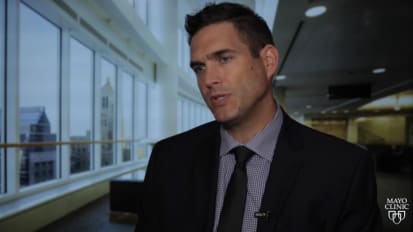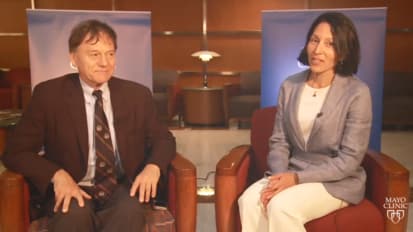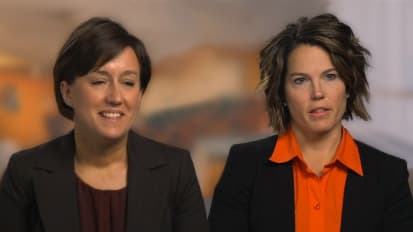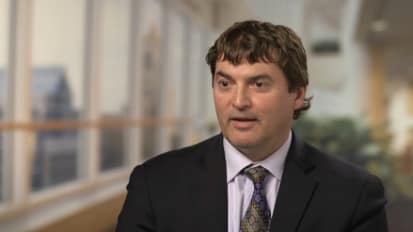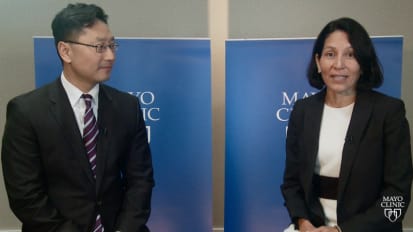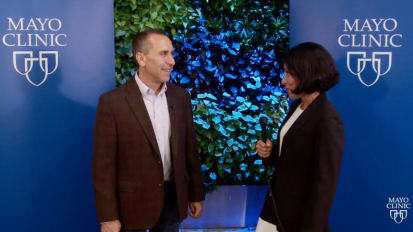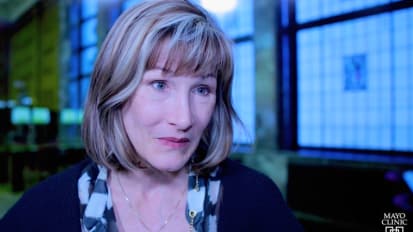Nathan K. LeBrasseur, M.S., Ph.D., co-chair of research in Physical Medicine and Rehabilitation at Mayo Clinic's campus in Rochester, Minnesota, discusses research at the Robert and Arlene Kogod Center on Aging with Carmen M. Terzic, M.D., Ph.D., chair of Physical Medicine and Rehabilitation, at the 2015 Fourth Annual Symposium on Regenerative Rehabilitation .
Dr. LeBrasseur believes there are fundamental underpinnings to diseases such as sarcopenia — the age-related loss of muscle — and other conditions such as Alzheimer's disease or osteoporosis. Mayo researchers are gaining an understanding of cellular senescence, a process in which cells stop dividing and become toxic to the tissues they are living in because of the factors they secrete. This process may have implications for muscle and regeneration.
In related work, Dr. LeBrasseur is involved in a multicenter clinical trial looking at ways to improve muscle health and enhance physical function in late life.
CARMEN TERZIC: This is the fourth annual symposium on regenerative medicine at the Mayo Clinic. And we are here joined by Dr. Nathan LeBrasseur, who is a member of the Department of Physical Medicine and Rehabilitation, and also an important member of the [INAUDIBLE] Center for Aging at the Mayo Clinic. And Dr. LeBrasseur gave a wonderful presentation this morning where he discussed aging and muscle. And I would like if he can give us a summary of his presentation. NATHAN LEBRASSEUR: Thanks, Carmen. So it's a fantastic symposium, and I had the opportunity to talk about her our and our interest in muscle really from the perspective of aging. So we believe that there may be fundamental underpinnings to diseases like sarcopenia, which is the age-related loss of muscle, and other conditions that most of us are very familiar with, like Alzheimer's disease or osteoporosis. And our work has really led us down this path of understanding a process called cellular senescence. And senescence is really a state in which cells stop dividing, and they become very toxic to the tissues that they're living in because of the factors that they secrete. And we think this may have implications for muscle, particularly muscle regeneration, because, during that regenerative process, cells need to divide in a healthy environment. And these senescent cells instead, not only do they not divide because they're in a state of stable growth arrest, but they secrete factors that probably prohibit regenerative capacity of different tissues, including muscle. CARMEN TERZIC: This is a very exciting new area of investigation. And I know, as you have commented before, that you're ready to start a clinical trial where manipulating or controlling sarcopenia may have a huge effect on aging. Could you comment about that? NATHAN LEBRASSEUR: Yeah, that's right. Yeah, so we're actively engaged in a multi-center clinical trial looking at ways to improve muscle health, to enhance physical function in late life. And we're hopeful it will also impact things like metabolism and frailty in older persons. CARMEN TERZIC: This is so great. So we are not going only to live longer, but very active. NATHAN LEBRASSEUR: That's right. Health span. Hit the wall running. So, that's great. CARMEN TERZIC: Thank you, Nathan, for joining us. And we were very happy to have you as part of the faculty in this symposium. NATHAN LEBRASSEUR: Thank you very much. It was a pleasure.

